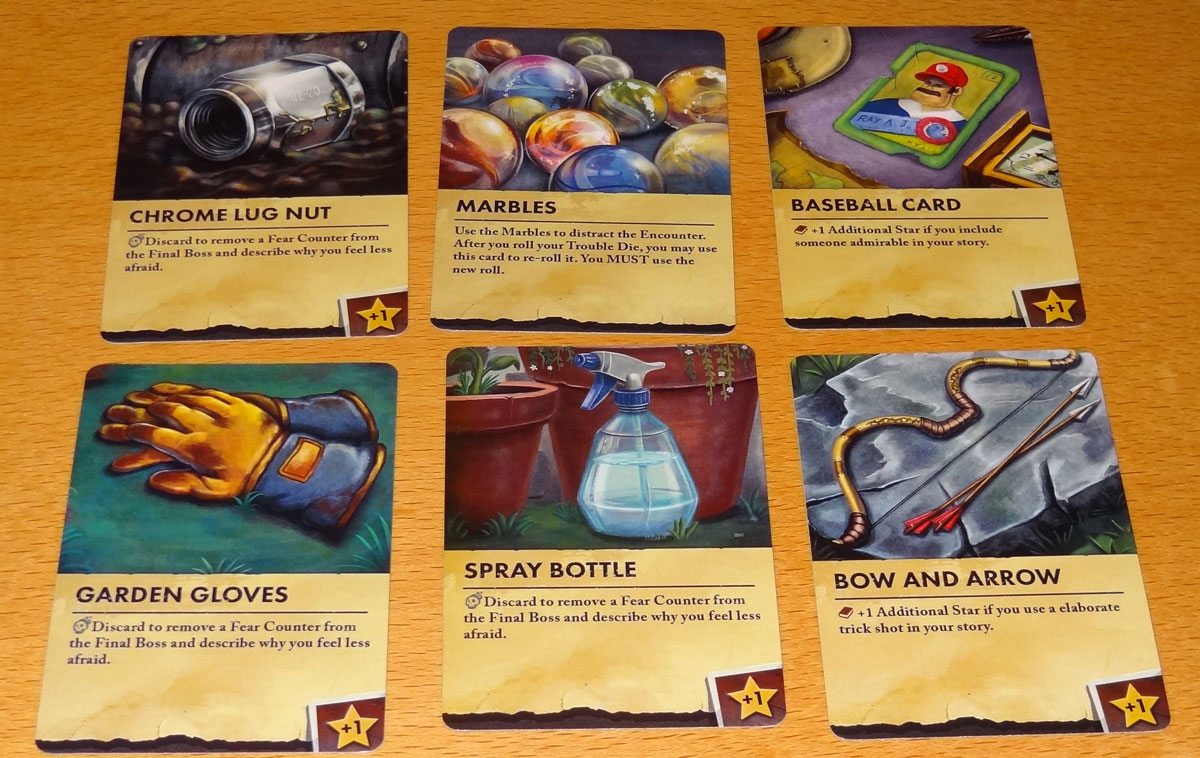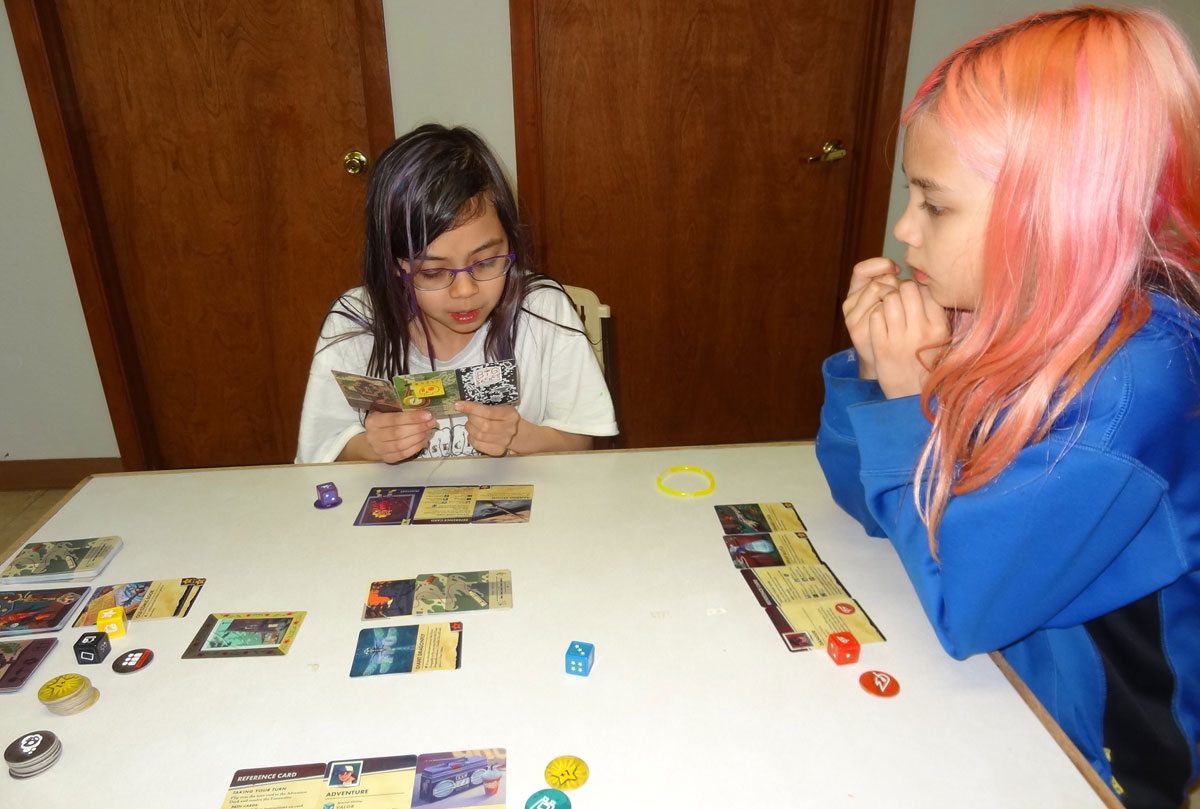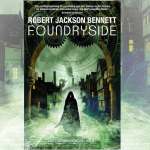You’ve got your lucky penny in your pocket and your siblings by your side as you sneak out to the abandoned junkyard–looking for adventure, danger, mischief, or mayhem. What will you find around that pile of rusted cars? Who knows what treasures are hidden just around the bend? Play The Siblings Trouble and find out!
At a glance: The Siblings Trouble is a cooperative storytelling game for 2 to 4 players, ages 8 and up, and takes about half an hour to play. It’s currently on Kickstarter with five days to go, with a pledge of $25 (plus shipping) for a copy of the game, or $60 for a limited deluxe edition in a wooden “book” box. I think the age rating is about right, though you could play with younger children with some assistance.

Components
The components list is subject to change, depending on whether stretch goals are hit before the campaign ends–there could be 4 alternate characters, a fourth location, and a second boss for each location.
- 4 Character cards
- 34 Treasure and Epic Treasure cards
- 39 Location cards (13 each in 3 locations)
- 30 Path cards
- 12 Big Secret cards
- End of Adventure card
- Home card
- 24 tokens
- 6 custom dice
- 4 reference cards

I got a prototype on loan to try out the game. Not all of the artwork was completed, but there was enough finished artwork to give a good feel for what it will look like. The illustrations are great–they look like something out of a picture book or a cartoon. The prototype came in a mock-up of the deluxe box, and it’s beautiful. (The box itself is the same, but the logo will be a nice vinyl label rather than the glued-on inkjet picture I have now.) The only thing that bothers me about the deluxe box is that, if this were a book, the logo would be sideways on the cover (though this might change). Still, for a game about trouble-making kids going on adventures, a book with a hidden compartment seems like the perfect way to store it.

Each of the four characters has an associated card (portrait on one side, power on the other), an ability token, and a custom die. Each of the player dice has four faces with stars on them, an Epic Fail side, and a Special Ability side. What’s also interesting is that each player has a different distribution of stars on the dice.
There are two other dice, the Treasure die and the Search die. The Treasure die is rolled sometimes when you pass an encounter, and can award a regular Treasure, an Epic Treasure, or a +1 Star token. However, it can also add Fear to the Boss or give you a -1 Star token. The Search die is rolled for certain Path cards, and can have various effects: gain a Treasure, add a Fear token, draw more Path or Location cards, and so on.
How to play
The real goal of the game is to have fun telling a story about going on an adventure, though ideally you’ll make it all the way to the Boss, defeat it, and grab an Epic Treasure before heading home. If all of you get sent home before then, your parents send you to bed early and the game ends.

First you’ll set up the Adventure Deck. Pick one of the locations (Hillside Caves, Abandoned Junkyard, Ancient Forest). You’ll build a deck starting with the location’s Entrance card and ending with the location’s Boss and then the End of Journey card. Along the way is a mix of Path cards and location cards, along with a Big Secret.

Each player gets a character card along with the associated die and ability token. Each player also gets a Treasure card, and tells a little bit about it and why they’re bringing it on the adventure.

Then, players take turns flipping over a card from the Adventure Deck and resolving it. The idea is that the cards act as prompts to tell a story. For instance, the first card, the Entrance, gives you a brief description of the location and asks you to fill in the story of how you got there–describe how you found the entrance to the caves, for instance. Some cards require you to roll the Search die, and will have further instructions if you roll the “card” symbol; otherwise, you take the result of the die roll.

Encounters will have a star value–these are things that you need to overcome, though you can do it however you like. Want to bash the spider with your Gnarly Stick? Go for it. Want to befriend the troll by sharing your Action Figure? Why not? It’s entirely up to you how you describe your action. Then you roll the die, and see if you get enough stars, and describe how your attempt worked or failed. Items can be discarded to add stars to your roll, and most of them have additional instructions that will boost their star power if you include certain things in your story.
You can ask a sibling for assistance, which lets them roll their own die and add it to yours. And, of course, there’s the Epic Fail–you can try to get somebody to rescue you, but there are some more limitations. If you fail to overcome an obstacle, you get sent home and will spend your next turn getting back to the rest of the group instead of flipping a card. If everyone is home at the same time, the adventure ends.
Pass an encounter, and you might get a reward–a Treasure card, perhaps, or a roll of the Treasure die (which could be good or bad).

When you get to the Big Secret card, you’ll reveal the Boss at the end, plus draw an Epic Treasure card and place it under the Boss. The Big Secret shows you how you found out about the Boss–maybe you decoded a secret message in a candy bar wrapper, or found a letter in a dusty attic. Once the Boss is revealed, there are effects that can add Fear tokens to it, making it scarier and harder to overcome.

If you ever roll your ability icon, you get to use your special ability–these differ by character. You also have an ability token that may be used once during the game to use your ability when you’ve rolled an Epic Fail.
That’s pretty much it–if you reach the end and defeat the Boss, you tell the conclusion of the story: what treasures you picked up during the adventure, how your parents reacted when you got home, and so on. If you all get sent home early, then your story has a different ending.
The Verdict
I had reviewed Ed Baraf’s previous game, Lift Off!, which was funded on Kickstarter last fall and is now on its way to backers, so when he got in touch with me about The Siblings Trouble, I was eager to see what he had come up with this time. Sadly, the first prototype he mailed was stolen off my porch (boo! hiss!) so I had to wait until another they got another one out to me.
The Siblings Trouble is a storytelling game, and if you’ve followed my reviews for a while you’ll know that I’m usually not much of a storytelling guy. I haven’t played a lot of RPGs and when I do, I like a lot of mechanical rules to help move things along. I’m not good at coming up with ideas on the spot, and although I really love storytelling tools like Rory’s Story Cubes and Storyteller Cards, I have to admit that the stories I’ve created with these tools have been pretty bare-bones and aren’t worth repeating.
So I approached The Siblings Trouble with a little hesitation. I would like for my kids to get into games that prod their imaginations. All of us love stories and reading books together, but my hope is that we can also create stories of our own to share, and games like this seem like they could provide a path toward that goal. But in order for a storytelling game to work, you need players who are willing to tell a story. I wondered: would that work if I weren’t a natural storyteller myself?

I’ve played a couple times now with my kids. First, a brief introduction: my oldest daughter is our talkative child. She’s always been very verbal, started reading early, and gives a running commentary of whatever is going on in her head. Our middle daughter has always been more quiet; she processes things internally and has a hard time putting things into words, but picks up on game mechanics pretty quickly. I’m always looking for ways to encourage her to practice using her words, and I thought a game with fun artwork and cool stories might do the trick. Meanwhile, would my oldest daughter be able to stop talking and listen to the rest of us?
My first couple plays with my kids were mixed: I played once with just myself and my middle daughter (the quiet one), and while we both enjoyed going through the Adventure Deck, our story was fairly minimal. When I added my oldest daughter to the mix, things were a lot more lively, but the stories she told weren’t always well-connected.
For instance, in one story we had just described following some unusual animal tracks. She drew a Laboratory, rolled the Search die, drew a Strange Place, rolled the die, drew a Stash of Weapons, rolled the Search die, and got the Gnarly Stick treasure card. (You’re not likely to get a long string of cards like this, but it’s possible.) She told us a story that visited each of these locations, but wasn’t very good at connecting them to each other, and then picked up the Gnarly Stick “for some reason instead of any of the other cool weapons in the stash.”
I spoke to the game’s designer Ed Baraf about some of the issues I’d run into, and got a few helpful tips. For one, I think it’s important to introduce the game by saying that the objective is to tell a fun story. If you think of the goal as “get to the boss and defeat it,” then you expect the mechanics of the game to do the heavy lifting. But if everyone understands that it’s all about the story, then the burden of making it fun and engaging shifts to the players, and it encourages people to listen carefully instead of just thinking ahead to your own turn.
Another tip is that not everything has to be taken literally. This one was particularly tricky for me, I think: when I see “Gnarly Stick” I assume it’s exactly that. But Baraf explained that the cards are all story cues, something to prompt you. So the Gnarly Stick could instead be a baseball bat, or maybe a sword, or a magic wand. The final rulebook will include some storytelling tips for players like me who need a little help getting started.

I did try playing The Siblings Trouble with some of my adult friends as well, and we had a fun time venturing into the Abandoned Junkyard. Maybe a little too fun–my daughter came down and scolded us for being too noisy. Our story involved tracking down a witch’s pet Cerberus, discovering an alien inside a big Sphinx statue, and facing off against a giant robot overlord. The people I played with were mostly new to storytelling and RPGs, but it still went well. It is sort of like a simplified RPG at times, and sort of like guided storytelling–it’s not as mechanically robust as, say, Dungeons & Dragons, but it’s more structured than Rory’s Story Cubes.

I really love the idea of The Siblings Trouble and I think it’s a beautiful game. The focus is definitely on the storytelling, with a light dusting of game mechanics to help direct the story, so it’s not intended for those who want a challenging cooperative game or a deeply strategic game. It’s for kids and kids at heart who love make-believe. If you love being transported into the world of stories, The Siblings Trouble is your vehicle–like a dirt bike with a basket on the handlebars.
For more information, visit The Siblings Trouble Kickstarter page. But don’t dawdle! There’s less than a week left in the campaign.





